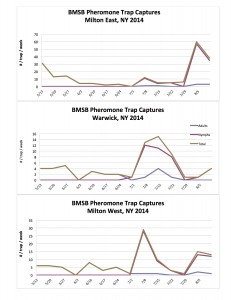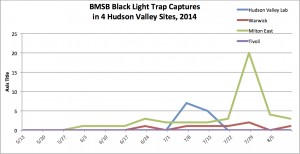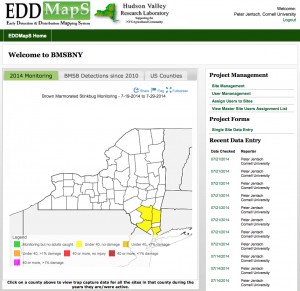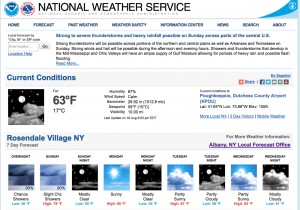Brown Marmorated Stink Bug (BMSB) numbers last week show continued increase of late instar nymph movement to pheromone baited Tedders traps. The late start to the season may have pushed forward the emergence of the overwintering adults later into the season. And cool evening temperatures over the past week may be slowing developmental progress. As mentioned in previous posts, the BMSB numbers have been a fraction (15-20%) of what we observed last season with no site showing levels of real concern. And although we are seeing an increase in nymph trap captures, they may not move to tree fruit or vegetable given ample rainfall, high relative humidity and viable deciduous tree hosts other then apple. Nymphs may not have quite enough time this season to give rise to a strong second generation. And as we have seen over the past few years, predicting the development of this insect has not been easy, so take this with a grain of salt. By the 1st week in September we should begin to see movement of BMSB to the urban environment. By that time we should know if BMSB will be a concern during the mid through late harvest period. For now, ‘all quiet in the eastern front’. 

Management Recommendations: If you are trapping along the orchard edge, and not seeing BMSB in the orchard BUT are seeing them in traps, we would recommend NOT SPRAYING. Trap captures should be used to initiate intensive monitoring of the crop, spraying only on first find of BMSB in the crop.
If you are finding adults in the trees, we would recommend management with border sprays at first adult edge find. Whole orchard applications should be made with the first nymph find as this event signifies an established population within the orchard.
Growers should consider spraying Alternate Row Middle (ARM) after the 1st of August if adults are scouted in the orchard, making whole orchard applications once nymphs are found. Continued scouting through to harvest is recommended.

The list of the most effective insecticides for BMSB management is found using this link. NYS labeled insecticides effective for use against the BMSB are available in four major classes including pre-mix formulations. Bifenthrin received an emergency exemption use permit (Section 18) to control brown marmorated stink bug (BMSB) on apples, peaches, and nectarines in Orange, Dutchess and Ulster Counties of NY. Products include Bifenthure and Brigade, showing the greatest degree of efficacy of the pyrethroid group.
Generally, stink bug are a dry weather insect pest, looking for water and nutrients in well irrigated agricultural systems after primary deciduous tree and weed hosts dry out. As we continue through the season we are likely to see increased movement of the pest to orchards, especially if we begin to experience drought conditions. The embedded image link to the EDDSMapS below will provide trapping data and levels of tree fruit damage by county as the season progresses.
This weeks weather forecast predicts warm temperatures in the low to mid-80’s with cool night time temps in the mid to upper 50’s. 

